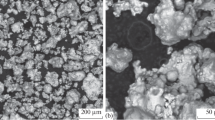Abstract
A thermochemical method has been used to make finely dispersed iron-silver composite powders for medical purposes. The physicochemical and biomedical properties have been examined. These Fe’MAg powders have been made with silver mass contents of 0.1, 1, 5, and 10%, and they have been found to be resistant to corrosion, nonpyrophoric, and bactericidal, and to have hydrophilic surfaces and to allow of thermal sterilization; during the formation of the powders, the behavior can be traced from the magnetic characteristics can be controlled depending on subsequent use. The powders can be used in medicine for example for the treatment of suppurating wounds, trophic ulcers, and so on.
Similar content being viewed by others
References
E. M. Natanson,Colloidal Metals [in Russian], Nauk. Dumka, Kiev (1959).
A. T. Pilipenko and I. V. Pyatnitskii,Analytical Chemistry [in Russian], Khimiya, Moscow (1990).
N. S. Buyanova, G. B. Gudkova, and A. P. Karnaukhov, “Determining the specific surfaces of solids by argon thermal adsorption,”Kinetika i Kataliz,6, 1085–1092 (1965).
V. E. Polyakov, I. G. Polyakova, and Yu. I. Tarasevich, “Determining the heats of wetting for finely dispersed minerals having low specific surfaces,”Kolloid. Zh.,38, 188–191 (1976).
S. Gregg and K. Singh,Adsorption, Specific Surface, and Porosity [Russian translation], Mir, Moscow (1970).
L. I. Kheifets and A. V. Naimark,Multiphase Processes in Porous Media [in Russian], Khimiya, Moscow (1982), pp. 90–95.
Adsorption in Micropores [in Russian], Nauka, Moscow (1983), pp. 200–204.
G. B. Bokii,Crystallochemistry [in Russian], Nauka, Moscow (1971).
K. Bauminger, S. G. Cohen, A. Marinov, et al., “Study of the low-temperature transition in magnetite and the internal fields actions on iron nuclei in some spinel ferrites, using Mössbauer absorption,”Phys. Rev.,122, No. 5, 1447–1450 (1961).
Yu. F. Krupyanskii and I. P. Suzdalev, “Size effects in small Fe3O4 particles,”Zh. Eksp. Teor. Fiz.,67, No. 2, 736–738 (1974).
T. Shinjo, F. Itoh, H. Takaki, et al., “Fe57 Mössbauer effect in Fe2B, FeB and Fe3C,”J. Phys. Soc. Jpn.,19, No. 7, 1252 (1964).
W. Wendland,Thermal Analysis Methods [Russian translation], Mir, Moscow (1978).
S. M. Navashin and I. P. Fomina,Rational Antibiotic Treatment: A Handbook [in Russian], Meditsina, Moscow (1970).
Additional information
Institute for Colloid Chemistry and Water Chemistry, Ukraine National Academy of Sciences, Kiev. Translated from Poroshkovaya Metallurgiya, Nos. 11–12(404), pp. 1–5, November–December, 1998.
Rights and permissions
About this article
Cite this article
Kushchevskaya, N.F., Shvets, T.M. Finely dispersed composite iron—Silver powders. Powder Metall Met Ceram 37, 571–574 (1998). https://doi.org/10.1007/BF02680107
Received:
Issue Date:
DOI: https://doi.org/10.1007/BF02680107




